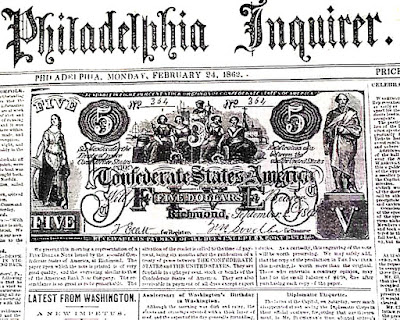In January 1849, Upham sailed on The Osceola to San Francisco, via Rio de Janeiro and Talcahuana, arriving in California on August 5, 1849, and participating in the California Gold Rush. Proving unsuccessful as a gold miner, Upham moved to Sacramento and founded the Sacramento Transcript, California's first daily newspaper published outside San Francisco. Becoming homesick in 1850, he sold his shares in the newspaper and travelled back to Philadelphia.
Here's an 1885 carte-de-visite of "Samuel C. Upham arrived in San Francisco, Aug. 5, 1847" by L. Horning, Philadelphia. The photo belongs to History of San Jose, who have stamped their name across the front.
The Wikipedia lists Upton's occupation as: "Journalist, lyricist, merchant, bookkeeper, clerk, navy officer, prospector, counterfeiter."
Samuel Upham made a lot of money during the Civil-War; Literally! At the outset of the war, he ran a small shop in Philadelphia where he sold perfumes, stationary, newspapers etc. He published a variety of patriotic and satirical novelty items including a topsy-turvy portrait of Jefferson Davis and a fold-in comic entitled "The Adventures of General Beauregard and his Charger." In both cases the subject is transformed into a mule.
The story is told that one day (February 24, 1862), Upham noticed that the Philadelphia Inquirer was selling out quickly from his shop and when he looked into it he found that the Inquirer had a fac-simile of a Confederate Bill printed on the front page. Someone remarked that the fac-simile was perhaps worth more than the original. (See Rare Newspapers).
Soon Upham was printing his own fac-simile Confederate bills. The early versions like this one, have the disclaimer/ad, "Fac-simile Confederate Note - Sold wholesale and retail by S.C. Upham 403 Chestnut Street, Philadelphia." printed across the bottom. (See Today I Found Out)
But, of course, the disclaimer could be easily clipped off.
In 1878 he wrote and published Gasology A Satire by John Donkey, consisting of a long run-on poem covering hot topics of the day. Here's Upham's pseudonymous self portrait from the cover of Gasology.
When Upham died of stomach cancer in 1885, a minor mystery ensued over the whereabouts of his wealth. His estate was valued at $4,889.97, but he claimed to have sold upwards of $50,000 worth of counterfeit notes during the war. The proceeds of his counterfeiting operation have never been found.
Ann, his wife died in 1898, (Ann Eliza Bancroft Upham). Their shared headstone in Mount Moriah Cemetery in Philadelphia says only:
S. C. U.
A. E. U














No comments:
Post a Comment